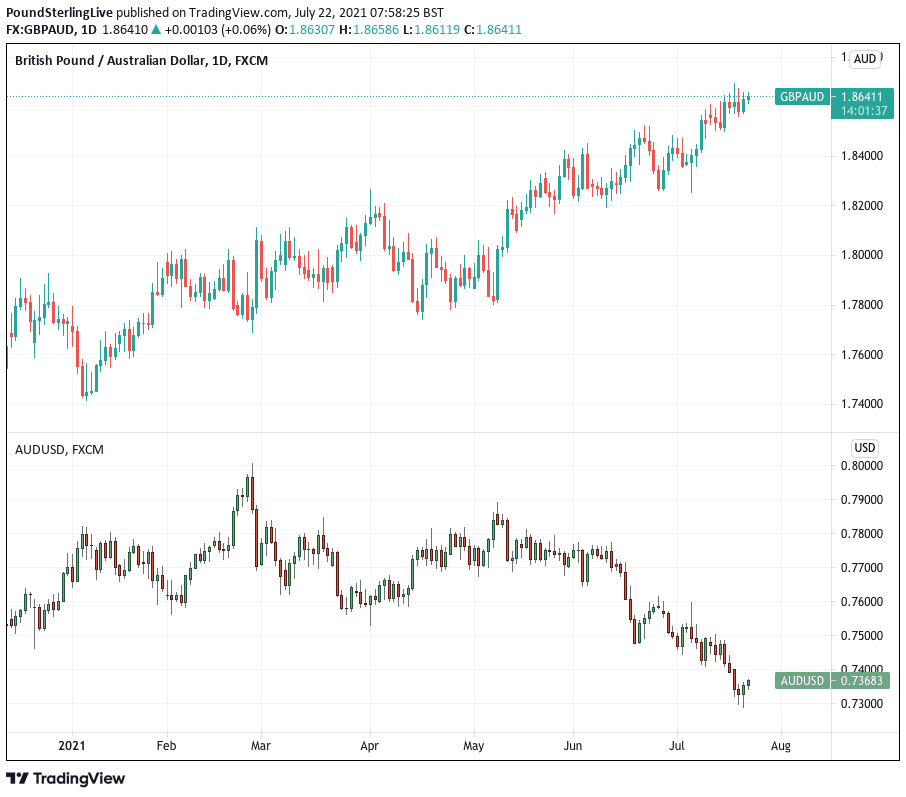Australian Dollar Prone to Further Losses as RBA Forced into Rethink Over Lockdowns
- Written by: Gary Howes
- RBA might abandon decision to end QE
- GBP/AUD can trend higher
- Aus economy faces tough Q3

Above: Sydney's Circular Quay during lockdown. Image © Adobe Images
- GBP/AUD reference rates at publication:
- Spot: 1.8635
- Bank transfer rates (indicative guide): 1.7980-1.8113
- Money transfer specialist rates (indicative): 1.8467-1.8505
- More information on securing specialist rates, here
- Set up an exchange rate alert, here
Media reports out this week suggest the Reserve Bank of Australia is likely to maintain generous monetary policy conditions in light of the current lockdowns, a view numerous economists now agree with.
The developments pose interesting questions for the outlook of the Australian Dollar, with analysts now expecting the currency to underperform due to the delay.
The RBA had been on course to reduce its quantitative easing programme by September, but with bond yields in Australia now rising in light of the Covid situation a rethink might now be required according to various media reports.
"Given that the RBA would prefer to give market participants plenty of advanced warning, the decision may need to be made and announced following the August Board meeting," says Damien McColough, Head of Rates Strategy at Westpac.
Secure a retail exchange rate that is between 3-5% stronger than offered by leading banks, learn more.
The Reserve Bank of Australia (RBA) currently holds interests at a record low 0.1% in order to support the economy through the Covid crisis.
Further support for the economy and financial system comes via its asset purchase programme that sees the RBA buy government bonds in order to keep the yield paid by those bonds as low as possible. This in turn suppresses the cost of finance throughout the economy thereby aiding businesses and consumers.
A strong economic recovery over recent months has meant the RBA could start walking away from these support programmes, a development that is on the whole supportive of the Australian Dollar's outlook.
The RBA last month reduced slightly the amount of Australian government bonds it buys under its quantitative easing programme from A$5BN to A$4BN, the value of purchases will total A$100BN and it is due to expire in September.
However, the imposition of strict Covid-19 restrictions in Sydney, Melbourne and South Australia means the economy faces a difficult third quarter and this decision might be reversed.
The Times today reports that long queues are forming again outside government welfare centres as companies in the largest cities effectively suspend workers on limited pay, raising fears that the rapid recovery from earlier waves of the pandemic is about to reverse.
The market senses a reversal in intentions at the RBA is now likely.
"Bond yields have moved down instead of up as tightening lockdowns in its two economically important states look set to crimp the country’s economic activity, fuelling talks that the September tapering timing could be delayed," says Magdalene Teo, Fixed Income Research Asia at Julius Baer.
{wbamp-hide start}
{wbamp-hide end}{wbamp-show start}{wbamp-show end}
"The AUD sold off owing to short positions by funds as the currency lost its carry advantage and to the prospect of tighter restrictions," she adds.
The Australian Dollar has unequivocally failed to benefit from the June decision by the RBA to scale down its quantitative easing programme, perhaps a sign that currency investors were not buying into the view that any significant tightening in monetary conditions was possible.
"Australia’s zero-Covid strategy with a poor vaccination rate has made the country vulnerable to the Delta variant," says Teo.
The Pound-to-Australian Dollar exchange rate has risen steadily through 2021 and is now at 1.8632. Given the UK economy is now fully open, has borders that are relatively open the prospect for further GBP/AUD upside commands a decent probability.
Furthermore, Pound Sterling Live notes signs are emerging that the acceleration in cases is slowing notably and therefore the third wave of Covid infections in the UK might be cresting.
We also reported yesterday that Commonwealth Bank of Australia are now forecasting GBP/AUD to reach 1.94 on the back of recent developments.
The Australian Dollar-to-U.S. Dollar exchange rate (AUD/USD) has meanwhile been trending lower since May and is now at 0.7368. The move has largely been driven by a reappraisal by investors over the outlook for U.S. interest rates.
Strong economic growth and high inflation levels in the U.S. mean the prospects of a 2022 rate hike at the U.S. Federal Reserve have grown markedly, this dampens demand for U.S. government bonds which in turn pushes up their yield and creates an external demand for the dollars.
This makes for a marked contrast with Australian bond market dynamics and poses potential downside for AUD/USD.
"Australian government bonds rallied hard as the government battles to contain the outbreak, which signals longer and harsher lockdown measures given low vaccination rates," says Teo. (Rallying bonds = falling bond yields).
The RBA will therefore feel inclined to remain active in the bond market to ensure bond yields stay under control, therefore exiting their quantitative easing programme over coming months is becoming an increasingly remote prospect.
"Lower yields and the economic fall-out from the pandemic have now prompted calls for the Reserve Bank of Australia to delay its quantitative easing (QE) taper that is slated to start in September this year," says Teo.






